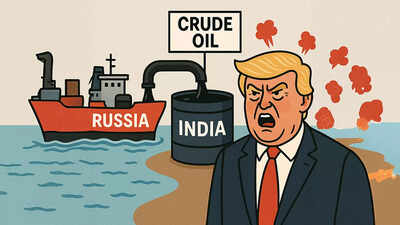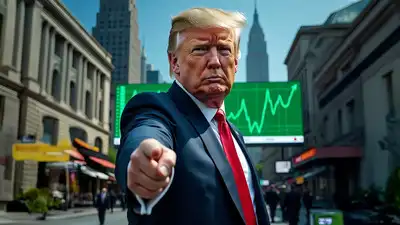India is faced with the prospect of an additional penalty from the Donald Trump administration for its procurement of oil and defence equipment from Russia. While announcing a 25% tariff rate for India this week, Trump also warned of a penalty for India’s trade ties with Russia.He specifically criticised these actions “at a time when everyone wants Russia to STOP THE KILLING IN UKRAINE.”“India will therefore be paying a tariff of 25%, plus a penalty for the above (Russian purchases), starting on August First,” he posted on Truth Social.India’s dependency on Russian oil has gone up significantly from a mere 0.2% prior to the Russia-Ukraine conflict to currently representing 35-40% of total crude imports! This shift has attracted renewed attention following US President Donald Trump’s announcement of additional penalties atop a 25% tariff on all US-bound goods.Also Read | Donald Trump’s 25% tariff: India expects minimal impact; indicates agriculture, dairy, GM food no-go areas in trade deal talksTrump administration officials have said that India buying oil from Russia is an ‘irritant’ for the US. How much crude oil does India get from Russia? What will happen if the US imposes a penalty and has India stopped buying Russian oil? We take a look:
How Much Russian Oil Does India Buy?
- Traditionally, India sourced the majority of its oil requirements from Middle Eastern nations, particularly Iraq and Saudi Arabia. This procurement pattern shifted significantly following Russia-Ukraine in February 2022.
- As the world’s third-largest crude importer, following China and the US, India began purchasing Russian oil at discounted rates after Western nations boycotted Russian supplies as a punitive measure against Moscow’s military actions in Ukraine.
- Russia has evolved from holding a minimal 0.2% share in India’s import portfolio before the Ukraine conflict to becoming the country’s primary supplier, surpassing both Iraq and Saudi Arabia, and reaching a peak share of 40%.
- Currently, Russian oil comprises 36% of India’s total crude oil imports, which is subsequently processed into various fuel products including petrol and diesel.
- India’s crude oil imports from Russia stood at 68,000 barrels per day in January 2022, as reported by Kpler, a global real-time data and analytics provider. During the same period, India received 1.23 million bpd from Iraq and 883,000 bpd from Saudi Arabia.
- Russia emerged as India’s primary oil supplier in June 2022, surpassing Iraq. Russian supplies reached 1.12 million bpd, whilst Iraq provided 993,000 bpd and Saudi Arabia delivered 695,000 bpd, according to a PTI report quoting Kpler data.
- Russian oil supplies reached their highest point at 2.15 million bpd in May 2023, with fluctuations based on available price discounts.
- The supply consistently remained above 1.4 million bpd, exceeding India’s pre-Ukraine conflict imports from its then-leading supplier, Iraq.
- Current Russian oil imports average 1.78 million bpd, significantly higher than Iraq’s 900,000 bpd. According to Kpler’s data, Saudi Arabia’s contribution stands at 702,000 bpd.
- Following western sanctions on Russian energy after the Ukraine war, Russia offered substantial price reductions to willing crude oil buyers. The difference between Russia’s primary Urals crude and the globally recognised Brent benchmark initially reached $40 per barrel, but has since narrowed to under $3.
In December 2022, G7 nations announced a $60 per barrel ceiling on Russian crude prices. This arrangement allowed European firms to continue shipping and insuring Russian oil deliveries to third countries, provided the sales price remained below the ceiling – aiming to maintain global oil supply whilst reducing Russian revenue.The European Union has recently adjusted the price cap to $47.6, incorporating an automatic review system. This revision aims to maintain the cap at 15% below average market prices.
US Penalty Risk For India
The recent EU ban on Russian-origin refined product imports, coupled with Trump’s warning, creates significant challenges for Indian refiners.According to analysts, if India is forced to shift away from Russian crude due to US threats of additional tariffs or penalties on Indian exports, the nation’s yearly oil import expenses could increase by $9-11 billion.According to a PTI report, Kpler’s Lead Research Analyst (Refining & Modeling), Sumit Ritolia, describes this situation as “a squeeze from both ends”.Also Read | Donald Trump to help Pakistan build ‘massive oil reserves’! How much known crude oil does it have & how does that compare to India? Top points to knowThe EU sanctions, which take effect from January 2026, could require Indian refiners to modify their crude intake patterns, whilst the US tariff threat suggests possible secondary sanctions affecting shipping, insurance, and financing aspects of India’s Russian oil trade.These combined measures restrict India’s crude procurement options, increase compliance risks, and create substantial cost uncertainties.India’s crude oil imports in the previous fiscal year exceeded $137 billion, which is processed to produce fuels including petrol and diesel.The situation is particularly critical for major refiners such as Reliance Industries Ltd and Nayara Energy, who together process more than 50 per cent in 2025 of India’s Russian crude imports, ranging between 1.7-2.0 million barrels per day (bpd).
Will India Stop Buying Crude From Russia?
Interestingly, India has substantially boosted its crude oil purchases from the United States following President Donald Trump’s re-election to the White House, according to an ANI report. Imports have risen more than 50% when compared with last year.“From January to June 25, India increased its imports of US average crude supplies by 51 per cent compared to the same period last year. (From .271 mb/d in January to June 2025 as compared to 0.18 mb/d in the same period last year),” sources told ANI.US President Donald Trump on Friday commented that India might stop purchasing Russian oil, describing it as “a good step” if accurate. However, India has consistently maintained its right to implement energy policies aligned with national interests.Also Read | Donald Trump’s 25% tariff, ‘dead economy’ jibe: India sends clear message to the US in 5 points – what Piyush Goyal saidWhen questioned about potential penalties for India and discussions with Prime Minister Narendra Modi, Trump stated, “I understand that India is no longer going to be buying oil from Russia. That’s what I heard, I don’t know if that’s right or not. That is a good step. We will see what happens…”India continues to maintain its independent stance on Russian oil purchases, with no directives issued to refiners to halt imports.. Both government-owned and private refiners retain autonomy in their procurement decisions, which are based on commercial considerations, sources told Bloomberg.Sources told ANI that Russia holds a significant position in global oil markets, producing approximately 9.5 mb/d, which represents nearly 10% of worldwide demand. As the second-largest crude producer and exporter globally, Russia exports about 4.5 mb/d of crude and 2.3 mb/d of refined products.Sources speaking to ANI specifically rebutted speculation about India discontinuing Russian oil purchases and Trump’s subsequent remarks supporting these reports.
How Much Defence Equipment Does India Buy From Russia?
Trump’s post on Truth Social not only targeted India’s oil purchases from Russia, but also its procurement of arms. The United States was the world’s largest arms exporter with a share of 43% in global arm exports between 2020-2024. Saudi Arabia, Ukraine and Japan are the main recipients of these exports.Russia was the third largest arms exporter in the same period, with a 7.8% share in global arms exports. This has dropped by 64% from 21% in 2015-2019. The main recipients of Russia’s arms were India, China and Kazakhstan.India ranked as the second-largest arms importer globally during 2020-24, accounting for 8.3% of worldwide arms imports. It saw a decline of 9.3% in arms imports when comparing the periods 2015-19 and 2020-24.Also Read | Russia oil squeeze: Trump’s 100% tariff threat – should India panic?This can be attributed primarily to India’s enhanced capabilities in indigenous weapon design and manufacturing, which has reduced its dependence on foreign arms procurement, according to the latest SIPRI report for this year.Russia’s contribution to India’s imports has declined to 36%, a substantial reduction from 55 % during 2015-19 and 72% in 2010-14.India has begun diversifying its defence procurement strategy by strengthening partnerships with Western nations, particularly focusing on France, Israel and the USA, SIPRI has noted in its report.






